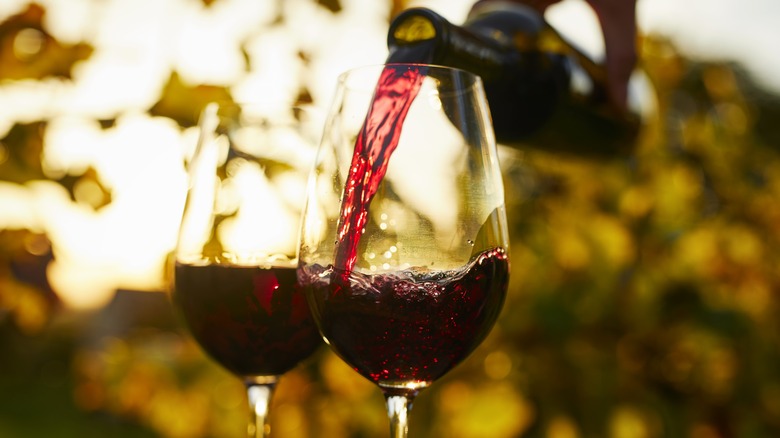The Science Behind Why You Should Store Leftover Wine In Mason Jars
Sometimes, the unthinkable happens: After entertaining friends or family, there are some not-quite-empty bottles of wine left over. For casual wine drinkers, the most instinctive thing to do might be to replace the cork and stick the bottle back in the fridge. But any wine expert will tell you that storing wine this way will degrade the wine's freshness and flavor. The reason? Oxygen exposure.
Shoving a cork or wine-stopper into an open bottle leaves the remaining wine in contact with all the oxygen filling the empty space, which is exactly what you don't want if you're trying to keep wine fresh. To avoid that, your best bet is to limit the wine's surface area and the amount of air space inside the bottle. The best way to do that is to transfer the leftover wine to a smaller container, like a mason jar.
Oxygen isn't all bad: During the winemaking process, some amount of oxygen exposure is necessary to bring out bright, fruity flavors and aromas and balance out some of the less desirable qualities, like a vegetal taste. It's the same reason people swirl wine in glasses once it's been poured: Oxygen helps the more bitter, astringent notes settle and lets a variety of other flavors shine through.
Smaller containers reduce wine oxidation
While some limited, intentional oxidation — known as aeration, or letting wine breathe — can improve a wine, oxygen is the archenemy of freshness (along with light and heat). The flavors of some wines can start to flatten out after as little as 30 minutes of sitting out, so don't wait to seal it up.
Storing partially-full bottles of wine standing up, rather than lying down, is one way to reduce a wine's surface area and thus better preserve it. But there's an even better way, and it doesn't involve buying any fancy wine-storing tools: Just pour the wine into a container that will have as little excess air space as possible.
Mason jars, being a common household item that comes in a variety of sizes, are a great option that you might already have on hand. Pick one that your leftover wine will fill up completely and screw the cap on tightly so that it's as close to airtight as you can get. Ideally, you'd do this immediately after pouring your glasses, so it's not oxidizing in the half-empty bottle while you enjoy.
Then store it in the fridge, where it's dark and cold, until you're ready to drink it — colder environments slow down chemical reactions like oxidation. It might be counterintuitive since they're generally not served chilled, but this goes for red wines, too. If you don't want to drink reds at fridge temperature, run the jar under lukewarm water to gently warm the wine.
Oxidized wine isn't ideal, but it's not dangerous, either
It's worth noting that when it comes to wine, careful preservation is more for the sake of flavor than safety. Wine doesn't really go bad the way fresh food does. When someone says a wine has "turned," they generally mean that its sugars and alcohol content have begun turning into acetic acid — the chemical reaction that turns wine into vinegar. And while vinegar isn't terribly pleasant to sip, it's unlikely to make you sick the way a spoiled pastrami sandwich would.
The one exception would be if a wine has spoiled not because it's oxidized, but because it's become contaminated with harmful bacteria. Contaminated wine can indeed cause food poisoning, but according to Medical News Today, this is very uncommon. Being that wine and vinegar have antimicrobial properties, it's not an ideal environment for bacteria like E. coli and salmonella to flourish.
If an opened bottle has gone a little bland and you're just not jazzed enough to drink it, you can always repurpose leftover wine by cooking with it, freezing the wine, or even turning the wine into jelly. But if you're not terribly picky, there's nothing wrong with drinking a slightly oxidized wine. Sure, a fancy restaurant may not serve it, but if you still like how it tastes, drink away — no sense letting it go to waste.


